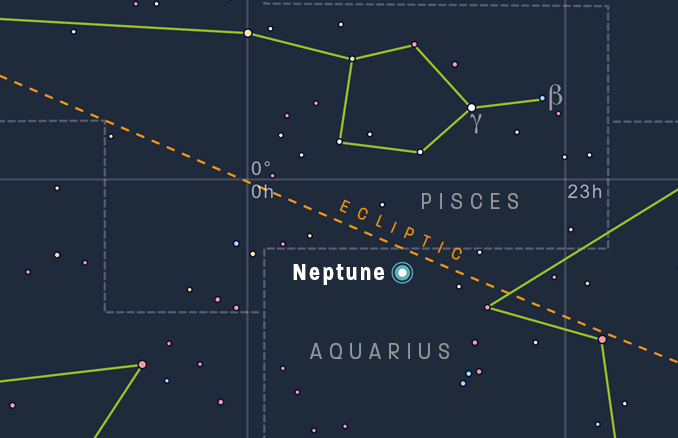Neptune is now positioned at its best for 2021 as it reaches opposition on on 14 September, when the Sun, Earth and Neptune line up. Neptune lies opposite the Sun in the sky, hence the term ‘opposition’. This is your best opportunity to track down and observe the eighth and currently the most distant planet known in the Solar System.

At opposition Neptune lies at an unimaginable distance of 4.3 billion kilometres (2.67 billion miles), which is nearly 29 times the average distance that Earth lies from the Sun (a distance termed an astronomical unit). From these dim and frigid depths of the Solar System, sunlight reflected from Neptune takes four hours to hit our retinas! Neptune is termed an ‘ice giant’ along with Uranus, the seventh planet from the Sun. Neptune is a large body, with a radius of 24,622 kilometres (15,299 miles), which makes it four times wider than Earth.
Despite its impressive physical presence, Neptune’s vast distance from us diminishes our Earthly view so much that Neptune is the only planet that’s not visible to the naked eye. Furthermore, a small- to medium-aperture telescope can struggle to show its relatively tiny disc. However, a glass-half-full observer would put a positive spin on matters and point out that a humble pair of binoculars is often all that’s required to locate magnitude +7.8 Neptune and an observatory-class instrument is not necessarily needed to observe or image the remote ice giant.
Neptune presently lies among the stars of north-eastern Aquarius, close to the boundary with Pisces to the north. It can be located around 4.3 degrees north-east of magnitude +4.2 phi (φ) Aquarii. This location means it peaks in elevation from London at altitude of around 34 degrees at about 1am BST. Neptune can be observed from about 10pm BST as it climbs higher in the south-eastern sky.

Observers based at mid-northern latitudes have had a very long wait for Neptune to achieve a workable peak altitude. Indeed, not since close to the end of the Second World War has Neptune appeared as far north in the sky. It lingered long in the depths of the southern sky for most of the later half of the twentieth-century. Now Neptune lies just around four degrees south of the celestial equator and is close to the end of its seemingly interminable journey to the northern sky!
Neptune takes around 165 years to complete an orbit around the Sun; back in 2011 it completed its first orbit since its discovery in 1846.
A modest-sized telescope in the 100–150mm (four- to six-inch) class, operating at around 100x, is powerful enough to resolve Neptune’s tiny, 2.3 arcsecond-sized blue-green disc. Unfortunately, even a large telescope struggles to glean much detail on its rather bland disc, though high resolution planetary imagers should have more success, especially when using infra-red filters in conjunction with an infra-red sensitive camera.

Unlike Uranus, Neptune boasts a giant moon, called Triton; in Greek mythology a god of the sea and the son of Poseidon and Amphitrite. Triton is 2,710 kilometres (1,680 miles) in diameter, ranking it the seventh-largest moon in the Solar System.
Triton completes an orbit of Neptune in 5.9 days, and from our perspective its unique retrograde motion along an elliptical path takes it as far away as 17 arcseconds from Neptune. Triton shines at magnitude +13.4, bright enough to be found through a 250–300mm (10- to 12-inch) telescope.
